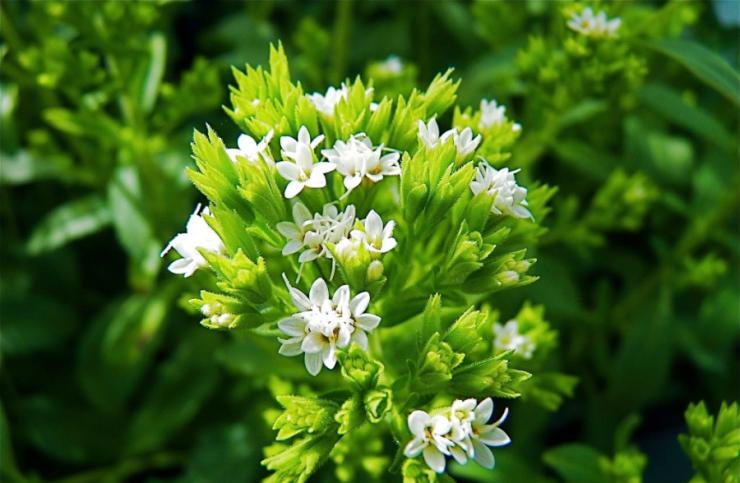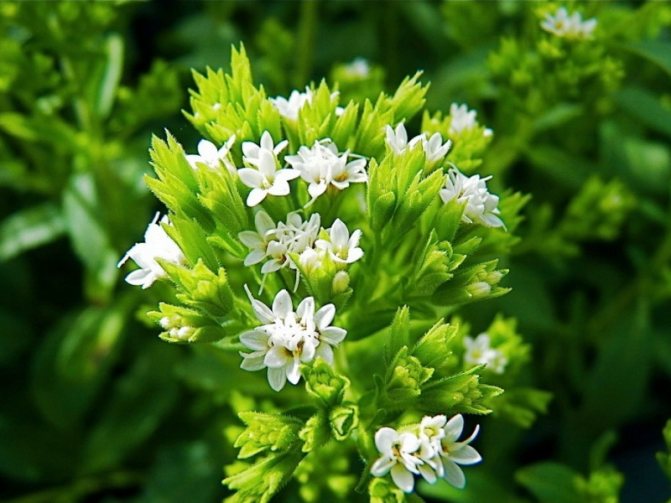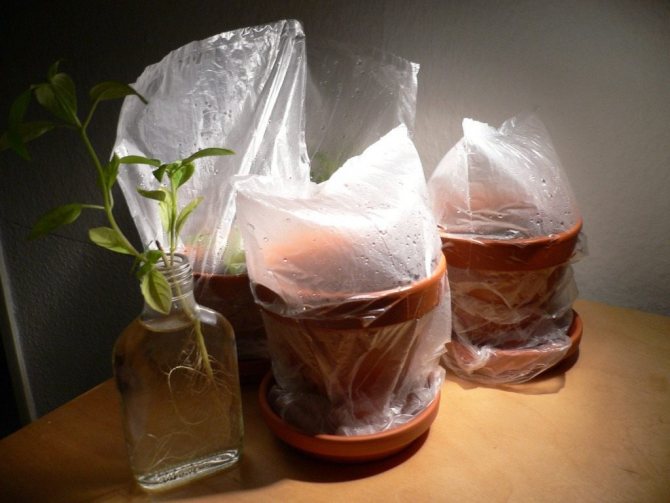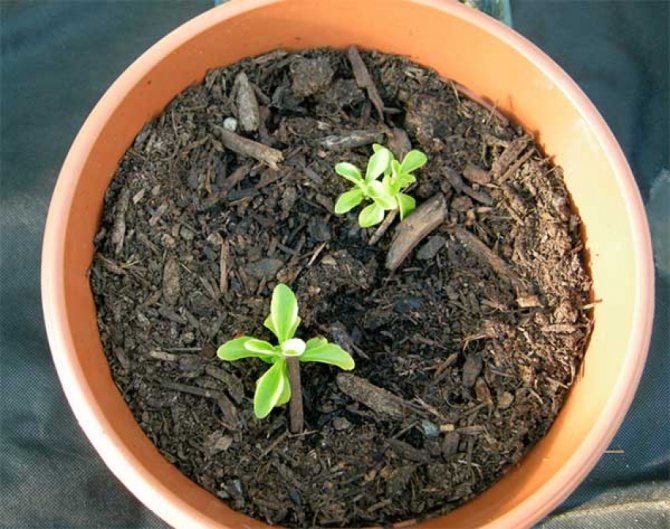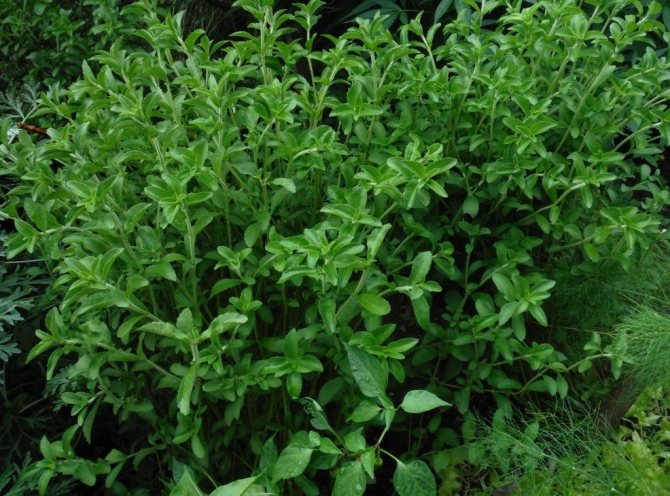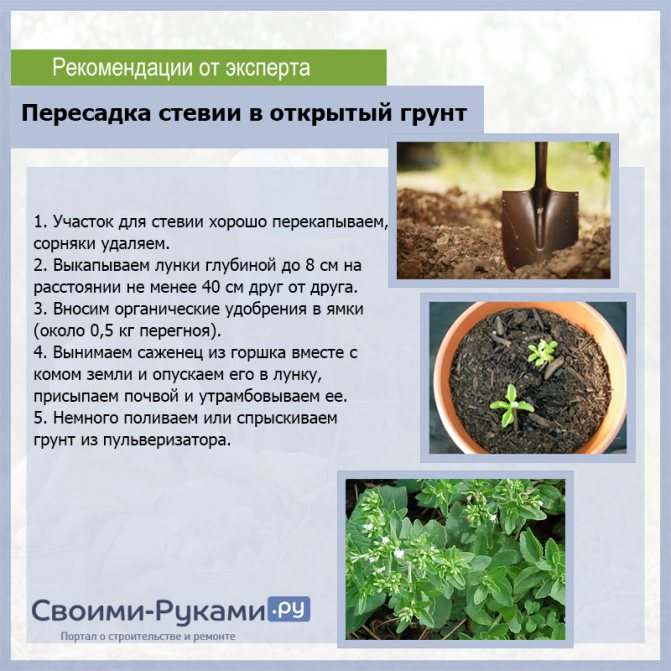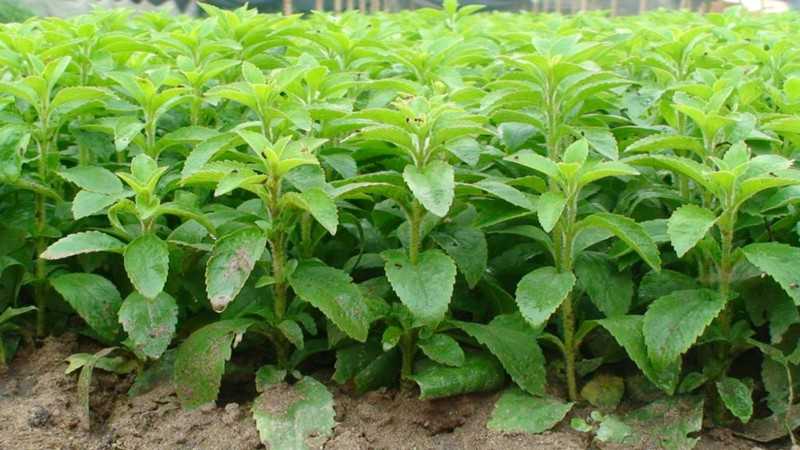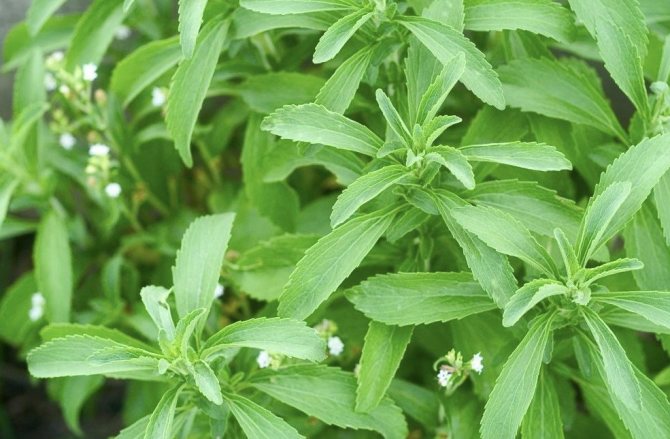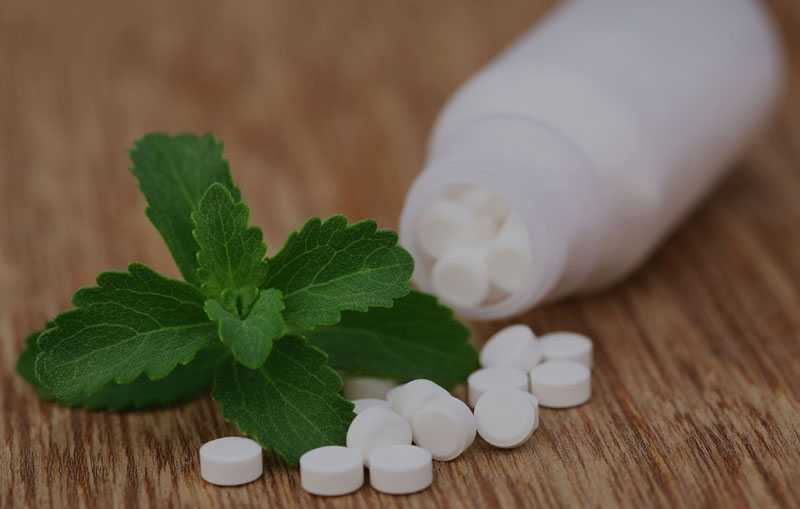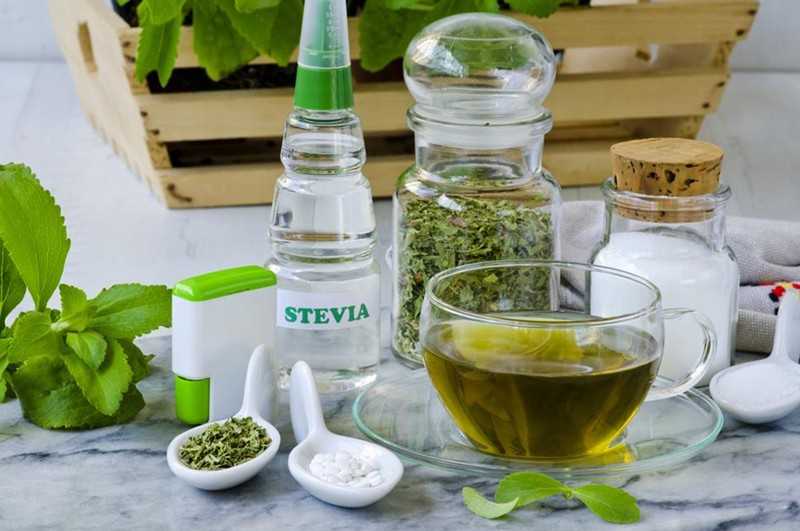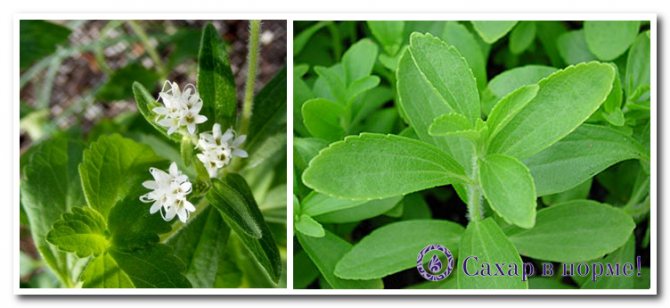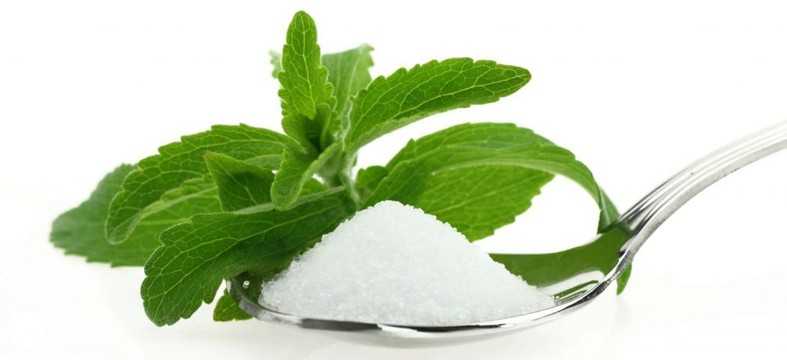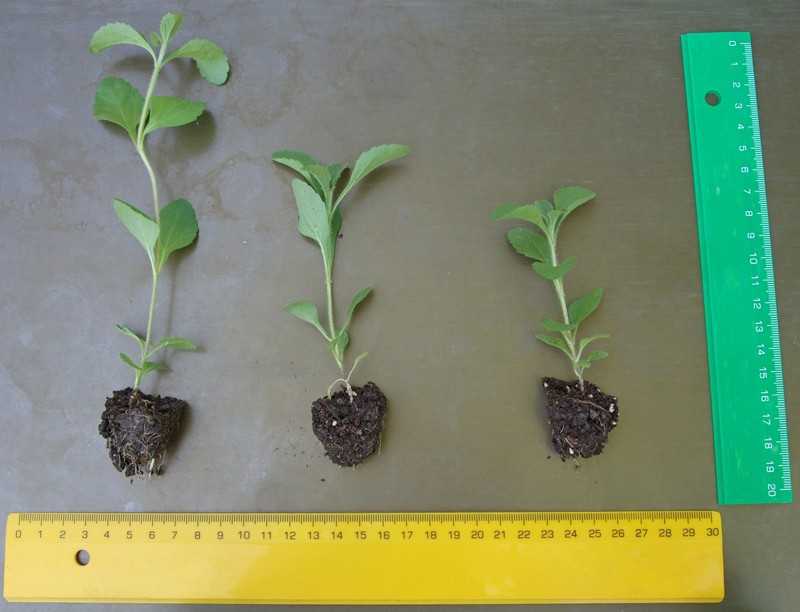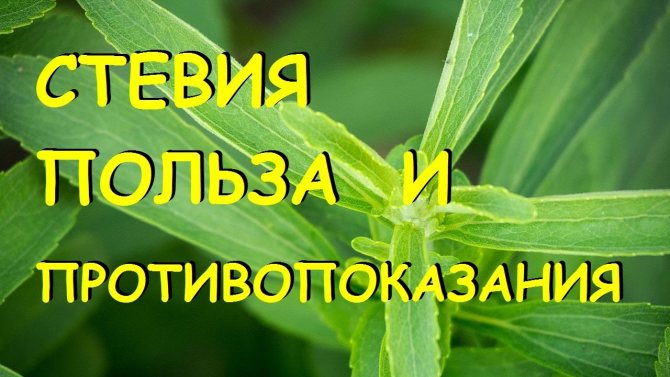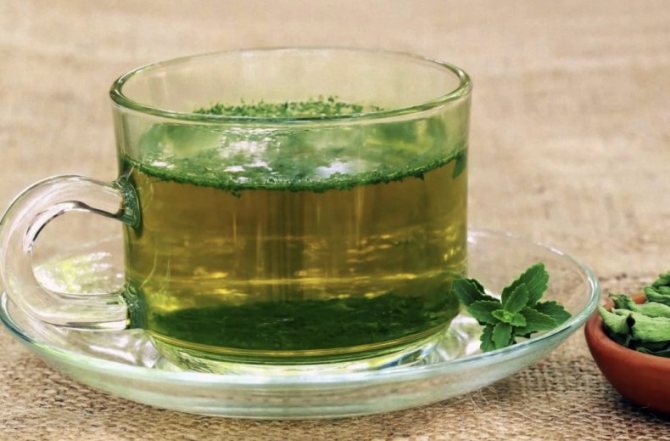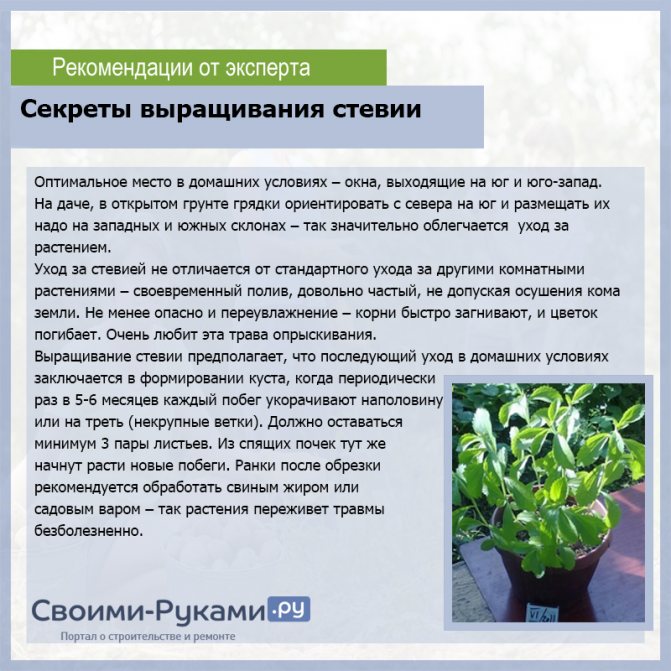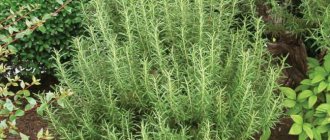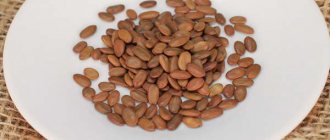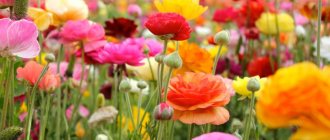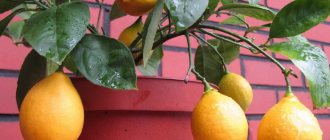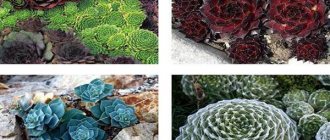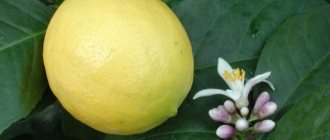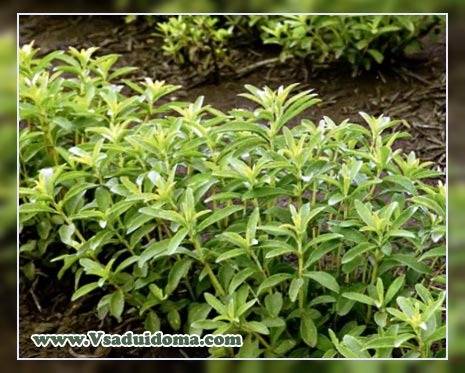
The stevia plant was first noticed by the Swiss botanist M. Bertoni at the end of the 19th century. He learned about the unique properties of the "sweet honey herb" from the Guarani Indians of Paraguay, who sweetened mate tea with stevia leaves, used it as a delicacy and as an additive to improve the taste of medicines.
Nowadays in the food industry, stevia is used as sweetener, sweetener... Its fresh leaves are 10-15 times sweeter than sucrose. Unlike aspartame, stevia sweeteners are heat-resistant (retain their properties at temperatures up to +200 ° C) and are stable in an acidic environment.
Stevia plant composition
Stevia Rebauda (Stivia rcbaudiana) contains many biologically active substances: carotenoids, mineral salts (potassium, calcium, magnesium, iron), tannins, essential oils, amino acids. Stevia is prized for the sweet organic matter (stevioglycosides) found in the leaves. In nature, their content varies from 3 to 9%, and in some varieties - from 15 to 20%. Some plants have an exceptionally sweet taste, others are less sweet, and still others are even bitter. This is due to the content and mutual ratio of bitter and sweet glycosides in stevia.
In stevia leaves, the most common components are stevioside (5-10%) and rebaudioside A (2-4%). Stevioside is 110-270 times sweeter than sugar, and rebaudioside A is 150-320 times sweeter. It is believed that the higher the ratio of rebaudioside A / stevioside, the higher the quality of the stevia cultivar. Breeders from different countries (mainly China, Japan, Korea and Russia) have developed varieties with a high content of stevioglycosides. In some varieties, their concentration reaches 20.5% (China), and the ratio of rebaudioside A to stevioside can even be 9: 1 (Japan).
Collection and drying of raw materials
The crop is harvested at the beginning of flowering. This usually occurs in late August - early September. It is during this period that the maximum amount of stevioside accumulates in the leaves of stevia.
The stems of the plant are cut at a height of 5-10 cm above the soil level and dried in a dry, ventilated room (in the attic), spread out in a thin layer on thick paper (kraft paper) or on newspapers.
The dried raw materials are threshed, the stems are thrown away, and the leaves are stored in glass jars with lids or plastic bags in a cool dry place. If the summer was hot and the stevia bloomed in July, then another harvest of leaves can be harvested.
How to grow stevia
This is a perennial herb about 65 cm high on fertile soils can grow up to 1.8 m. Flowering occurs when the length of daylight decreases. For planting, it is advisable to choose a sunny place: in the shade, these plants bloom and grow worse. Stevia prefer loose, well-drained soils (for example, slightly acidic loams and sandy loams). Sand and humus must be added to clay soils.
At temperatures below +20 ° C and a day length of less than 12 hours, stevia stops growing. It cannot hibernate in the open ground in the Moscow region, therefore it is grown as an annual or as an indoor culture and brought into the house for the winter.
To do this, in late September - early October, the plant is dug up with a lump of earth, transplanted into a pot and kept at a temperature of + 8 ... + 15 ° C and high humidity.
True, in low light, the shoots are still strongly stretched.In the spring, when the threat of frost has passed, the plant is planted in the garden and used as a mother plant for cuttings.
What it looks like and where it grows
This plant is common in Central and South America, China, Brazil and Israel. Stevia grows only in subtropical conditions; it does not hibernate in a continental climate. Honey grass is also common on the southern coast of the Crimean peninsula.
Outwardly, stevia is a low shrub that does not reach a height of seventy centimeters. The leaves of the grass are deep green, oval and elongated. Inflorescences are small, white.


Reproduction of stevia
Propagation of stevia by seeds
For sowing, a soil mixture is used, consisting of equal parts of sod land, humus and sand. In late March - early April, the seeds are sown evenly, without burying, in a well-moistened substrate. The inoculated dish is covered with glass or foil and placed in a warm place. The soil should always remain moist. For seed germination, a temperature of + 20 ... + 25 ° C and good lighting are required. After 5-7 days, most of the seeds emerge, after which the glass (film) is removed. Seedlings grow very slowly. At the age of 15-20 days, the plants are transplanted into cups without pinching the roots.
For good growth, seedlings need backlighting, regular careful watering and a temperature of about +25 ° C.
At the age of 6-7 weeks, seedlings are planted in open ground; usually in late May - early June, when the threat of frost has passed. They are planted with a row spacing of 45-60 cm and a row spacing of 25-30 cm. Seed germination is often very low, less than 50% (usually due to poor fulfillment).
Seedlings are weak - only half of the sown survives. To obtain viable seeds, the flowers must be pollinated with pollen from another plant. Seeds are best stored at 0 ° C, but after 3 years their germination is still halved.
How it can be used in cooking
Stevia can be used in cooking as a leaf, powder, or extract. Honey grass leaves can completely replace sugar when added to tea or coffee. The decoction of the leaves is also unusually tasty. They can also be added to compotes or fruit and berry cocktails. The powder version of the plant is used to make marshmallows, jam, cookies, pies and cheesecakes. The plant extract will be a good sweetener in the preparation of ice cream and fruit desserts.
Growing Stevia: Personal Experience
Diabetes patients use it as a sugar substitute.
Almost everyone knows this. But the “healing range” of stevia is much wider. Our local herbalist told me about the beneficial properties of the plant. It turns out that dried leaves and stems are effective in the treatment of ulcers with their help to normalize blood pressure.
Stevia leaves contain essential oils that help relieve inflammation and heal wounds.
They say using the plant correctly can even reduce your cravings for tobacco and alcohol!
Stevia came to me with a small cut. I have rooted it and have been watching the plant for 2 years already, I try to propagate it in winter.
In the open field, the bush grows rather quickly, the soil is needed with a high nitrogen content. And since I use stevia for medicinal purposes, I do not add mineral fertilizers to the soil. I use only organic. At the end of May, I plant the bushes in open ground at a distance of 20 cm from each other. For two weeks the plants adapt, then (with regular watering) they grow.
In freedom, they grow much more vigorously than in the house, and the leaves in the open sun store more sugars. When buds begin to appear, I cut off the ground part and lay it out in a dark, well-ventilated place to dry.
After pruning, I feed the plants with infused organic matter (weeded grass and manure), which I dilute 1:10.
Wintering setvia
With the onset of cold weather, I dig out the bushes, plant them in containers and put them in a cool, bright place.
Sometimes, as the earthen clod dries, I water it.
Saving stevia is not easy: some specimens sometimes die right away. At this time, the growth of stevia slows down, a period of rest begins.
Stevia cuttings
Young shoots appear in the spring. I cut them off, leaving two lower buds on the stem. I put the cut parts in water for 1 hour, then plant them in light sandy soil and cover with polyethylene.
Nadezhda TERYAEVA. Zhlobin, Gomel region
Specialist comment
Since stevia is not officially recognized as a medicinal plant and has not yet been included in the State Pharmacopoeia of the Russian Federation, I would recommend using it very carefully. And not to use by patients with hypertension, pregnant women and children.
On the treatment of alcohol and tobacco addiction, I have not come across information anywhere. Considering that stevia has a blood-purifying and antitoxic effect, it is logical to assume that it can help relieve hangover and improve well-being.
STEVIA: SWEET HOTEL
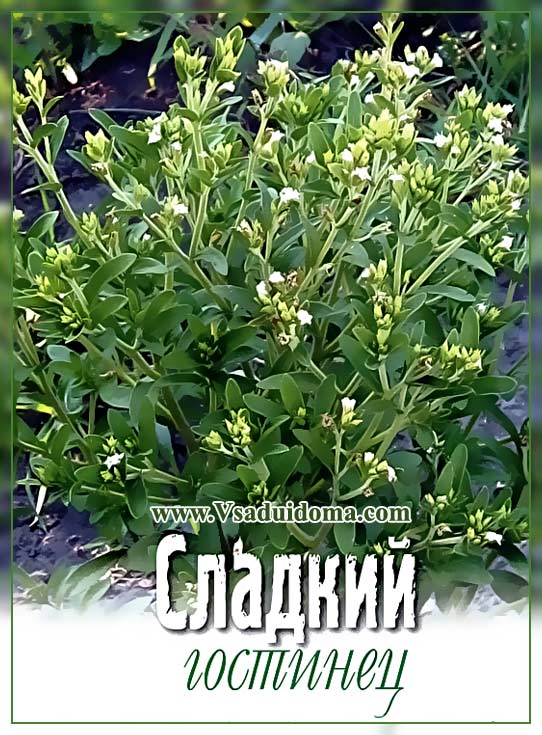

Stevia photo
Stevia (sweet herb) has been talked about and written about a lot lately. Interest in her has increased dramatically after in 1990, at a world symposium in China, stevia was recognized as one of the most valuable plants that can improve health and prolong life. This herb is also known in Ukraine. Despite the exceptional thermophilicity of stevia, some gardeners, including me, still managed to breed it on their plots.
Honey potion
Perhaps no plant in the world has experienced such vicissitudes of fate as stevia. Tear and chew for health - this is how it was perceived for a long time in Paraguay, in the homeland of this plant. Locals did just that, while maintaining one of the lowest diabetes incidence rates in the world. The first reports of a sweet herb used by Indians to sweeten food date back to 1887. It was in this year that the South American naturalist Antonio Bertoni discovered stevia. He described, studied, classified the plant as a botanist and gave it the name Stevia Rebaudiana, after Ovid Rebaudi, the scientist who pioneered the chemical analysis of sweet stevia juice. Then it was opened again, then forgotten ...
After the atomic bombings of Hiroshima and Nagasaki, the Japanese added a new page to Stevia's track record. In a hurry, they began to look for an adaptogen (a drug that increases the body's resistance to harmful effects) of plant origin. The choice fell on a South American plant, which they began to actively use for the health of the nation.
On the market of the Land of the Rising Sun, this plant began to occupy more than 80% of the world harvest and 90% of the consumption of dry leaves. Huge funds were directed to the cultivation and purchase of its raw materials in other countries. Until recently, stevia was known only to specialists. But after the Chernobyl tragedy, the popularity of the plant has sharply increased, the demand for medicinal raw materials from stevia has increased tenfold. Scientists, doctors started talking about her, articles appeared in newspapers and magazines.
Dry stevia leaves are 30 times, and the sweetening ingredient (stevioside) is 300 times sweeter than sugar. But not only this brought the plant worldwide fame. The main advantage of stevia is that it provides energy to a person without the help of insulin, which is especially important for diabetics and for those who have high blood sugar levels.
In addition, the plant helps to strengthen blood vessels, inhibits the growth of neoplasms, helps with diseases of the gastrointestinal tract, accelerates the utilization of bad cholesterol and radionuclides from the body.With the constant use of the extract from dry leaves, the body is rejuvenated, the skin on the face becomes smooth and elastic, wrinkles are smoothed. It is not difficult to prepare such a hood at home. For this, 1.5-2 tbsp. tablespoons of dry stevia leaf are poured with 1 glass of water, boiled for 6-8 minutes, and then infused for 45 minutes.
This extract is added to tea and to all dishes that traditionally use sugar.
Growing stevia is not easy. She cannot stand the winter and dies.
This plant only tolerates slight frosts. You can propagate sweet grass by cuttings, layering, dividing the bush, and seeds. Having tried all the methods, I opted for the propagation of stevia seeds. However, there are some nuances here too. Considering that the stevia seeds are very small, and their germination rate is low, even minor deviations from agricultural technology dramatically reduce the seedling yield. I, for example, do this. I perfectly level the moistened soil mixture, consisting of turf and humus in equal parts and 20-25% of sand. I compact and water. Peat cannot be used, as the bacteria in it will lead to the death of seedlings. I soak the seeds for 30 minutes in warm water with the addition of potassium permanganate (0.5 g per 1 L of water), then dry them and sow them evenly on a moistened soil surface.
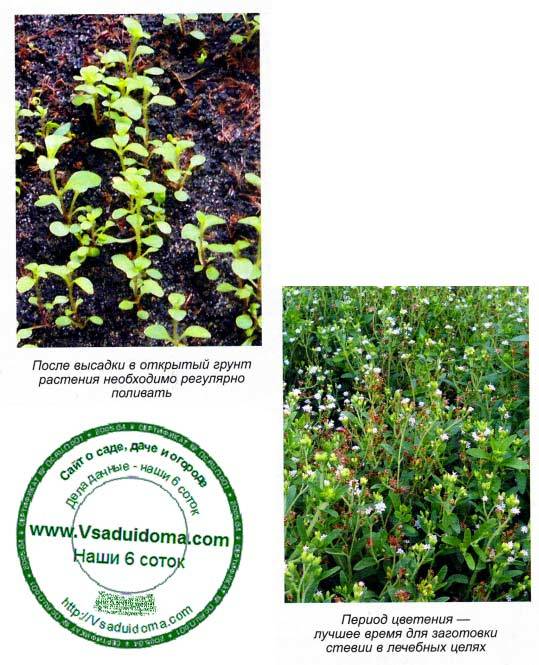

Stevia photo and care
For better contact with the soil, I press the seeds with my palm and lightly sprinkle them with soil on top, or rather, powder them. If the seeds are completely covered with soil, they will not sprout. I water the crops, not allowing the seeds to wash off, and cover with a film. The soil under the film must always be moist. During this period, it is important to protect crops from direct sunlight, for example, shade with newspapers. I put the seedling boxes in the warmest place for this time. After 6-8 days, shoots of stevia and weeds appear. It is very easy to distinguish them: the weeds are stretched out, there is no stevia. It is best to sow seeds on February 20-25.
After the emergence of seedlings, I transfer the seedling box to the brightest and warmest place. Seedlings grow very slowly. During this period, it is important to spray the seedlings regularly (at least 6-8 times a day) and monitor the temperature and humidity. The plant should be under the film throughout the entire seedling period. When two or more true leaves appear, I transplant the seedlings, along with a lump of earth, into separate pots. Seedling care is usual - watering, feeding.
I plant stevia in open ground in the third decade of May, when the threat of frost has passed. If there is film or agrofibre, the plants can be planted two weeks earlier. In each hole I bring 0.3-0.5 kg of vermicompost or humus and 2 tbsp. tablespoons of ash. Planting scheme: distance in a row between plants 35-40 cm, row spacing 60 cm.
I was convinced that the plants grow and develop better in the open field, if they are covered with foil or agrofibre for at least 2-3 weeks. Under the shelter, you can carry out foliar feeding of plants with chicken droppings. To do this, pour 2/3 of a bucket of fresh chicken manure with water above the level of the droppings. The droppings will begin to decompose, and the carbon dioxide will dramatically accelerate the growth and development of the stevia.
After planting, the plants need to be watered regularly, especially in dry years. When the stevia blooms, it is a signal that it is time to harvest the healing leaves. During this period, the greatest amount of stevioside accumulates in the leaves. I dry the plants cut at a height of 10-15 cm from the ground in the shade. I harvest stevia for seeds at the end of August - September, when the pedicels of the plants turn black. You need to carefully monitor the maturation of the seeds, if they are not removed in time, they will scatter.
Growing stevia in the garden is a chance to solve your health problems without resorting to medications. Thanks to this plant, which has unique healing properties, many ailments have been forgotten in our family. I advise you to make friends with stevia too.
Great stevia recipe
KULICH WITH STEVIA
Sour milk - 300 g, flour - 220 g, cottage cheese - 100 g, vanilla sugar - 8 g, baking powder - 4 tsp, lemon peel - 2 tsp, stevia extract - to taste, raisins - 100 g.
Stir the curdled milk with baking powder and leave for 10 minutes. Rinse the raisins, dry and mix with 1 teaspoon of flour. Grate the zest of one lemon. Stir in cottage cheese, vanilla sugar, lemon zest and stevia. Pour in the yogurt and beat with a mixer. Add sifted flour and raisins, stir. Fill the cake mold 2/3 full with dough. Bake in the oven for about 1 hour.
Stevia recipes
Because stevia is used as a sugar substitute, here is the ratio of the sweetness of these products. A teaspoon of sugar is:
- 1/8 tsp powder;
- 5 drops of liquid extract.
Thus, a whole glass of sugar can be replaced with just two tablespoons of powdered stevia or 2 teaspoons of liquid stevia. This significantly reduces the calorie content of the final meal and the amount of carbohydrates obtained. The exact ratio of sugar to stevia is best checked on the manufacturer's label, because the finished product may contain different concentrations of sweetener.


Syrup
The recipe for homemade stevia syrup is simple. The finished product can then be used in other recipes or as a tea sweetener.
To prepare a liter of syrup, you will need a jar with a tight lid with a capacity of 3 liters, dry leaves of honey grass (150 g) and about 1.25 liters of vodka. Pour the leaves into a jar, add vodka and stir. The vodka should cover the leaves by 2 cm. Then cover the jar with a lid and shake. Let it brew for a day (no more, otherwise the leaves will give bitterness).
After a while, you need to strain the infusion through cheesecloth. You will get an alcoholic extract. To evaporate alcohol, it is necessary to warm up the liquid, preventing it from boiling. After evaporation, the solution should be poured into a closed container. You can store it for 2-4 months.
Berry compote
The stevia compote recipe is no different from the usual one. To prepare a liter of berry compote, you will need about 50 g of dry stevia. For example, a raspberry compote is prepared as follows: a glass of raspberries is poured into a liter jar, stevia is diluted in hot water and the berries are poured with this solution, after which they are pasteurized for 10 minutes.
Stevia leaf tea
Stevia is available in tea bags for making tea. The drink is prepared 2-3 minutes after the bag is filled with 90 ° water. The amount of water in relation to one sachet must be found in the instructions on the package.
To preserve the herb's healing properties, it is recommended to brew whole leaf stevia. A tablespoon of dry leaves is needed for a glass of boiling water. The drink is infused for 10 minutes, and then filtered.
Apple pie
If you've already made stevia syrup, then the task of making a pie is greatly simplified. For the dough, melt 250 g of butter, mix it with 3 eggs, 3 cups of flour and 1.5 tbsp. syrup. The dough is kneaded, rolled out. The filling of sliced apples (4-5 pieces) is laid on it. The pie is baked for 30-40 minutes at a temperature of 180 degrees.
Stevia cookies
To make vegan stevia cookies, you must first brew 200 ml of stevia leaf tea. Then the infusion is mixed with 170 g of oat flour (you can half with rice), 70 g of pumpkin puree (or any other fruit) and 100 g of large raisins. Knead the whole mixture, form a cookie and bake at 200 degrees for 40 minutes.
Stevia plants - a healthy sweetness
Experienced gardener and herbalist Nikita Ilyich KOTOVSKY advises
Probably many of us wondered if sugar is harmful or healthy. Moreover, contradictory information on this matter constantly appears in the media and advertising of various sugar substitutes flashes. One of the main components of these substitutes is stevia.This plant will be discussed today.
Stevia is worth trying!
Stevia leaves contain a huge number of vitamins (A, C, D, E, P, PP), trace elements (calcium, potassium, zinc, selenium, phosphorus, iron, cobalt and others), glucosides, amino acids, essential oils, fiber. Therefore, it will be very useful to grow it on your own site. However, this is not so easy to do.
The fact is that you are unlikely to find stevia seedlings, and the seed germination rate is only 5%. But it's worth a try.
First you need to grow seedlings. To do this, purchase a stock of stevia seeds. Prepare soil and planting pots. The land should be a mixture of humus, turf and sand in equal proportions. Fill the pots with earth. Pour the seeds on a saucer and cover with lukewarm water for half an hour. Then take out and dry them. Sprinkle the potted soil with warm water. Sow seeds to a depth of 3-5 mm. Cover each pot with a plastic bag and place in a warm place. Seedlings should appear in 5-10 days.
Since stevia is a warm and moisture-loving plant, it must not only be watered, but also sprayed. Add a complex mineral fertilizer to the water for irrigation about 1 time in 7-10 days.
And now into the ground
It is necessary to plant stevia in open ground in June, when the average daily temperature is already high enough. A month before, at the place chosen for planting (it should be sunny and without stagnant moisture), you need to weed out all the weeds, and mix the earth with humus and sand in equal proportions.
Stevia should be watered daily (if there is no rain), weeded and fed with manure 2 times a month (1 kg of manure per bucket of water per 1 square meter of soil). If suddenly the soil around the plants becomes covered with a white bloom, then such a bed must be watered with a weak solution of potassium permanganate.
Stevia usually blooms in early August. It is at this time that you need to harvest its leaves. Cut them off, departing from the top 20-30 cm. Then lay them out on paper in a ventilated room (not under the sun!).
Preparing for winter
Stevia is a thermophilic plant, so wintering in the open field is excluded. And in order not to have to grow it again from seeds, it is necessary to preserve the existing plants. To do this, at the end of September, cut the stem of the plant so that only 2-3 leaves remain from the ground. Carefully dig up the plant along with a clod of earth and transplant it into a pot. Water once a week. As soon as the spring sun begins to warm up the room, transfer the stevia to a sunny window and start watering more often in preparation for transplanting into soil.
Treatment plant
Stevia, in addition to sweetness, has many other beneficial properties - anti-inflammatory, antimicrobial and diuretic. It is useful for diseases of the gastrointestinal tract, cardiovascular system, increases immunity, lowers blood pressure and promotes weight loss, improves the functioning of the gallbladder and liver.
Stevia can be used as a remedy in 2 types - as an additive to tea (coffee) and as an independent drink.
Stevia is easy to make. Take a few fresh leaves, pour boiling water over them and let it brew for 5-7 minutes. The use of such a drink leads to weight normalization and improved digestion.
As an additive 8 tea, you can use crushed and dried stevia leaves or its infusion. To prepare the infusion, take 1 tbsp. l. chopped leaves, pour 1 cup boiling water and put on fire. Cook for 5-7 minutes. Then remove the infusion from heat and leave for 5 minutes. Then pour into a thermos - let it brew for 8 hours. Then strain and add 1-2 tsp. in your favorite drinks. Store the infusion in the refrigerator for no more than 3 days.
Pruning adult plants
When the shoots in the greenhouse or at home on the windowsill reach 20 cm, and after planting 2 months have already passed, we trim the tops.The best time to do this is from mid-May to early June. Thus, we will contribute to the appearance of lateral shoots that create a shrub in several branches, which can be used for food in the fall. We cut off the shoot in such a way that a part of it with a couple of internodes remains on the adult plant.
Rooting stevia cuttings
We are not in a hurry to throw away the remaining cuttings, because with their help the reproduction of stevia is faster and more reliable than by planting seeds. Stevia cuttings are rooted as follows:
- put them in a jar with slightly sweetened water (1 tsp sugar per 1 liter);
- cover the container with an opaque material, preferably black. In the dark, roots appear faster;
- so that the stalk is stable, we fix it in a cardboard stand placed on the jar so that the leaves do not sink into the water;
- every 3 days we change the sweet solution, and for the early appearance of roots we spray the leaves with it.
With this home care, it will be possible to transplant stevia into the soil in two weeks.


We keep the newly planted plant under a film or glass, and open it not earlier than a week later. To take root stevia will need high air and soil humidity. Agrotechnology of stevia involves transplanting it into open ground after at least two months from the moment of seed germination. In the air, we continue to regularly spray and water the pre-hardened plant to achieve maximum sweetness with the leaves, because stevia grown in the country, and not at home, will be the sweetest. Now that we have figured out what planting and caring for this plant is, we will find out what stevia harvesting can be.
SEEDING AND GROWING STEVIA: VIDEO
Sowing and growing stevia.
ORDER QUALITY AND CHEAP SEEDS AND OTHER PRODUCTS FOR HOME AND COTTAGE. PRICES ARE BOTTLE. CHECKED! JUST SEE YOURSELF AND BE AMAZED. THERE ARE REVIEWS. GO >>>
Below are other entries on the topic "Cottage and garden - do it yourself"
- Stevia: growing from seeds and cuttings: How to grow stevia with seeds and ...
- Stevia - growing properties and benefits: Stevia plant - growing in ...
- Herbs sweeteners - stevia and lipia: planting and care: GROWING STEVIA AND LIPPIA: ON ...
- Lobia (hyacinth beans) - what kind of plant is it: Lobia plant consumption and cultivation of Lobia ...
- Square peas planting and care: Growing square peas Wave potatoes ...
- Cestrum - home care: Cestrum flower - cultivation Growing: easy Location: ...
- Hypoestes - planting and care: Growing hypoestes at home Family ...
Subscribe to updates in our groups and share.
Beneficial features
The chemical composition of the leaves of the plant has a beneficial effect on the work of the internal organs and systems of a person, especially with the correct course application.
The main useful properties will be the following:


- strengthens the vascular wall, has a relaxing effect on blood vessels;
- lowers blood pressure and heart rate;
- stimulates cell renewal and regeneration, normalizes metabolic processes in them, which prevents premature aging;
- has a tonic effect on the body, improves general condition, adds energy;
- promotes the elimination of harmful cholesterol from the body, leading to the formation of atherosclerotic plaques;
- stimulates the release of the intestines from toxins and toxins;
- lowers blood glucose levels due to the rapid processing of sugar that enters the body with food;
- promotes the rapid formation of cell membranes;
- normalizes metabolic processes, helps to reduce body weight;
- positively affects the state of the visual apparatus, prevents a decrease in visual acuity;
- envelops the intestinal walls, allows you to maintain a healthy microflora;
- strengthens the immune system, prevents frequent colds and viral pathologies;
- promotes the release of the body from parasites.
In addition, stevia-based preparations have anti-inflammatory and bactericidal effects.
KORODETSKY || Stevia - a step towards immortality
Planting stevia outdoors
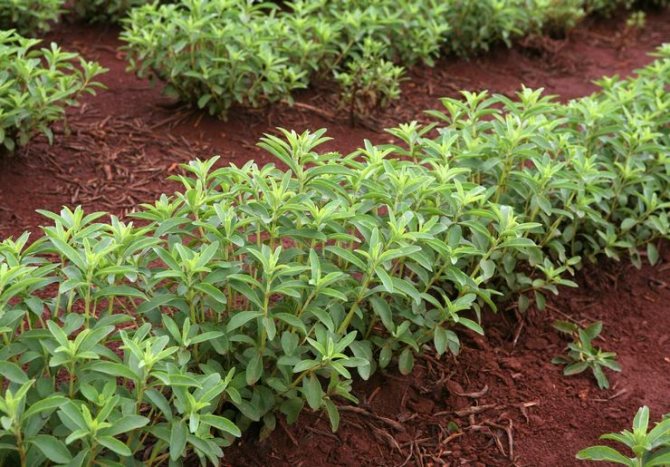

The site for planting stevia should be well lit and protected from wind and drafts. The soil should be loose and slightly acidic. If the soil in the garden is not suitable and heavy, it is necessary to add humus, sod soil and coarse sand to it during digging. It is not necessary to add peat, as it will make the plant grow poorly. The content of lime in the soil is also not permissible.
You need to plant seedlings in prepared holes. The distance between the plants should be about 35-40 cm. The distance between the rows is 50-60 cm. After planting, the soil around the plants should be well compacted and sprayed with plenty of water. Then gently spud each bush and mulch the soil with herbal ingredients. The roots of the plant are on the surface and therefore can suffer from drying out.
Doctor's opinion about stevioside and its use in diabetes mellitus
Is stevia good for diabetes? As an overweight and diabetes professional and specialist, I absolutely endorse stevioside as a safe sugar substitute. I recommend it in my consultations, I also advise the places where you can buy it. For type 2 diabetics, it helps to reduce the intake of carbohydrates from food and lose weight. In general, in medicine, and endocrinology in particular, it can increasingly be heard in the recommendations of doctors.
As a consumer I have been using this sweetener for 3 years. We have already tried herbal stevia tea, 150 tablets in a dispenser for sweetening drinks such as compote, and an extract in the form of a syrup. I recently bought a powder from an online store, the package is on its way. I like this unusual taste, and so does my son. And really sugar does not rise.
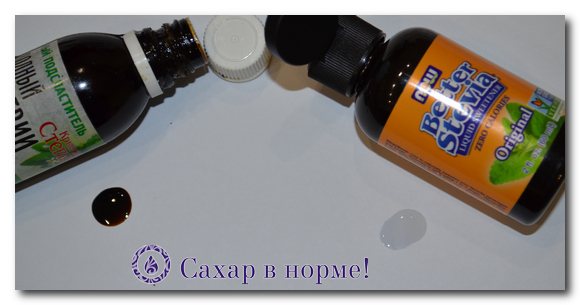

I had to try several types from different companies before I found a taste that I liked. In the photo you can see two bottles of stevia, the one on the left of the Russian-made “Crimean stevia”, and on the right - the stevia of the American company Now Foods. In the next photo you will see what these liquids look like.
I like the American version more, because it practically does not have that very aftertaste and is more concentrated. This product does not spoil the taste and appearance of desserts, unlike the Russian one. You can also drip Crimean stevia into tea, not so noticeably.
Indications for using honey stevia
- diabetes mellitus type 2 and 1
- impaired glucose tolerance
- overweight
- everyone who looks after their health
- while following the Atkins and Ducan diets
Contraindications and side effects
In fact, stevia has practically no contraindications, because it has no side and toxic properties. Some complain that she's sick. It must be remembered that stevia is an herb, and some people are allergic to herbs. Therefore, people who are allergic to the Asteraceae family (chamomile, dandelion) are advised to refrain from using it.
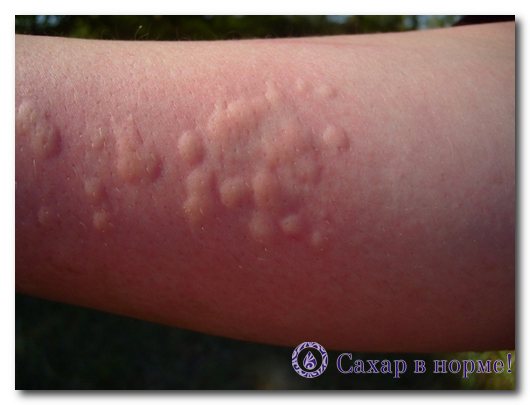

It may also be just an individual intolerance to the drug and this also needs to be taken into account. In general, stevia is more suitable than ever as a sugar substitute for diets with diabetes.
It can be used by people with chronic pancreatitis, pyelonephritis, cholelithiasis, and even with oncology. If candidiasis is present, stevia will not support the inflammation because it is not metabolized by the Candida fungi.
Stevia during pregnancy and breastfeeding
Can pregnant women take stevia? Opinions differ on this score. There are no reliable data on both safety and obvious toxic effects in pregnant women.But I personally think that stevia is a completely safe plant and can be used during pregnancy, but when breastfeeding (HS) it is better to refrain from taking sweeteners, suddenly the child will develop an allergy. The same applies to pregnant women who themselves suffer from allergic diseases.
Stevia for children
Can a child have stevia? Since stevia has proven to be non-toxic, it is ideal for children, unless of course you are allergic to it. As parents, we are responsible for the health and nutritional habits of a child that he will carry over into his adult life. I understand that cravings for sweets are inherent in children’s blood, but in our world there are too many of these sweet temptations and it is necessary at least in this way to neutralize the negative consequences of the use of modern sweets.
How and which stevia to choose
The question is rather difficult, because it is a matter of taste. I do not really like the taste of tea with this herb, but I can perfectly tolerate the water extract. My only advice is to try different flavors until you find yours. Products on sweet grass are sold in pharmacies, supermarkets, and online stores. I can share where I buy liquid stevia and other health products. This is a well-known site ru .. You can simply enter the name into the search bar and choose what suits you best for the price. Lasts for a long time, very concentrated and sweet solution. If you are making an order for the first time, you can use the code FMM868to get a discount. At the end of the order, this code must be entered in the "Apply referral code" field
Which is better: fructose or stevia
Well, this question is not even discussed. Of course, stevia is much better than fructose. I am in favor of fructose in fruits and vegetables, because it is found there in small quantities, but when they start using fructose powder, for home cooking or eating store goods on fructose, I am always against it.
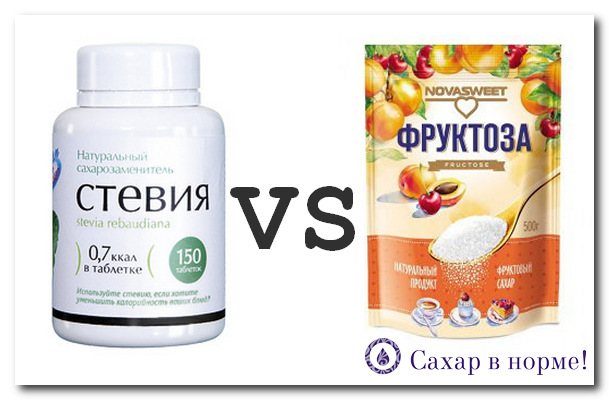

First, fructose is also a carbohydrate and it also raises sugar and insulin levels, only much more slowly than glucose. Secondly, these are extra empty calories that add inches to your waist. Thirdly, the body does not particularly need fructose, because it cannot be used as energy, and it is forced to settle in the liver, turning into fat, and part of it is converted into the same glucose and goes to energy needs. This is not the case with stevia. It does not affect carbohydrate metabolism at all and is not deposited in the liver, so it is a choice, if any, between these substances.
Stevia care during the season
Despite the fact that stevia loves good lighting, in the first week after planting in the ground, it is advisable to stretch a material that is semi-permeable to sunlight over it, for example, gauze. In 14 days after transplanting seedlings or cuttings, feeding begins. The first can be carried out with complex mineral mixtures diluted according to the instructions.
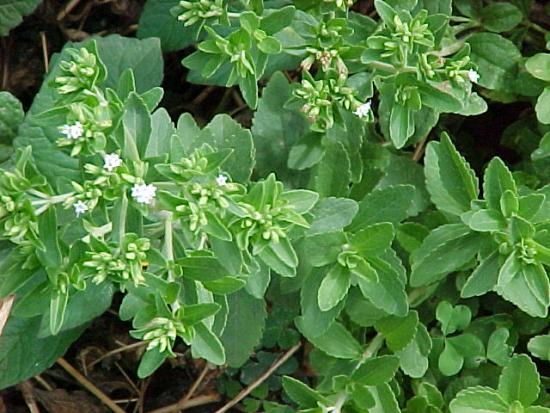

The next feeding is carried out after another two weeks. A mullein diluted in water will do in proportions of 1 to 10. The frequency of the next dressings is once every 14 days. Also, during the entire planting season, stevia is weeded, removing weeds while simultaneously loosening the soil under the plants. In hot summer, stevia planting needs systematic additional watering at least once every 3 - 5 days.
If stevia care is organized without big errors, then by the fall you can get powerful bushes more than a meter high. For personal use, the green parts of the plant are dried and applied as needed.
Growing conditions
Stevia respects warmth and sunlight, so it should grow in a well-lit place that is protected from drafts and gusts of wind, and the ideal air temperature for it should be at least 22 degrees.It is also worth remembering that you cannot plant stevia in lowlands, where water can accumulate - its excess for the plant is destructive.
Stevia is relatively not picky about the soil - it can grow everywhere, as long as the soil is not too salty. The ideal soil for her is light sandy loam and sandy substrates with the addition of organic fertilizers.
Stevia respects compost and humus, but you should be careful with peat, as it grows poorly on it.
Legumes are good predecessors for her. The soil pH should be in the range of 5.5-6. If only clay soil is present in the garden, then sod, humus and coarse sand should be added to it so that it becomes loose and light - such as Stevia loves.
Stevia care, watering, feeding
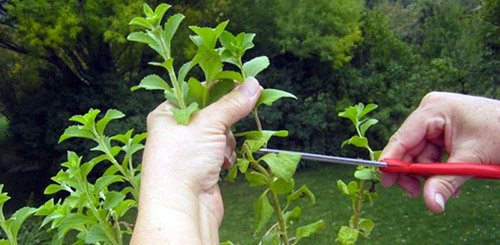

Outdoor stevia care involves first weeding (or mulching) the soil, watering, feeding and, in some cases, pruning.
Timely watering is especially important for this crop: it does not tolerate drought. The point of growth and the tops of the shoots should not be allowed to wither and dry out. This is a lot of stress for the plant. In this regard, stevia is very similar to bell peppers. In any case, it should be watered just as often and abundantly - 1-2 times a week. And in dry hot weather up to twice a day - in the morning and in the evening. From time to time it doesn't hurt to just spray the bushes over the leaves.
Stevia is fed twice a month. The first feeding is carried out two weeks after transplanting into the garden. It is best to use a solution of complex universal fertilizer, diluted strictly according to the instructions. From organic fertilizers, mullein (1:10) or weed infusion are suitable.
When the stevia grows up to 60 centimeters, the bush can be cut by a third. The cut parts are used for their intended purpose, and the growth of new shoots will begin on the remaining ones. It is unlikely that this technique will be needed in the first year of cultivation, but in the future, when propagated by rhizomes and favorable weather, the stevia bush is able to grow more than a meter in height.
Diseases and pests
The good news is that stevia has no pests or diseases in Russia. Unless a "black leg" can attack the seedlings, or some kind of rot is formed if excessive moisture is present. But all this can be easily prevented by observing the rules of agricultural technology.
Contraindications and harm
Despite the benefits of the plant for human health, it is not always allowed to use it. Pregnant and lactating women are not recommended to use the herb for medicinal and prophylactic purposes. It can affect the development of the fetus and the quality of breast milk.


Stevia's ability to lower blood pressure makes it impossible to use it in the therapy of patients who suffer from persistent hypotension. A critical decrease in indicators leads to a significant deterioration in the patient's condition.
Patients with a tendency to allergic manifestations should also not use stevia for treatment. A contraindication is the period of recovery of the patient after severe operations on internal organs.
When a large number of plant-based products are consumed, nausea, vomiting, decreased appetite, weakness, a sharp decrease in blood pressure numbers, dizziness, headache, and drowsiness are possible.
Grass allergy manifests itself in the form of a rash on the skin, itching, peeling, irritation, redness. Symptoms usually disappear after stopping the use of the funds. If the symptoms worsen, you should immediately consult a doctor.
Dividing the bush
Seeds do not germinate all. Out of a dozen - somewhere 3-4. Therefore, many people prefer propagate stevia by dividing the bush... I also gradually switched to this method.
In the fall, dig 1 stevia bush and put it in a box. He overwinters well on your windowsill, and in the open field, stevia freezes in winter. On dark winter evenings and gloomy mornings for 2 hours.light the grass with a lamp, otherwise it will start to taste bitter from lack of sun.
Maintain the shape of the bush without letting the shoots stretch too far. Cut from them, leaving 3-4 pairs of leaves. If you have a cellar, you can store it there. stevia roots in a box with earth. Then there will be no worries with her at all. Only in March, put the box on the windowsill and water the roots so that they sprout. At the end of spring, divide the bush into parts and plant it on the beds, leaving 30 cm between the plants.
Top dressing of honey grass
1 time it is advisable to apply mineral fertilizers to the soil per week. The condition of stevia is improved when feeding with slurry at the rate of 1 liter per bucket of water or fresh mullein.
Spend the procedure is recommended once every 2 weeks. Each bush is allocated 0.5 liters of top dressing. Interesting! Top dressing increases the number of leaves by 80%.
We have prepared an interesting article on the medicinal properties of Kalanchoe pinnate.
Passionflower flowers need some care. More on this.


